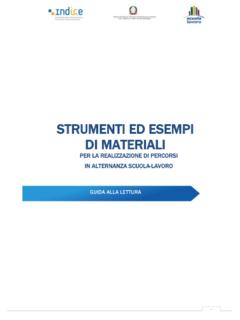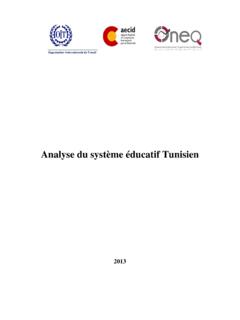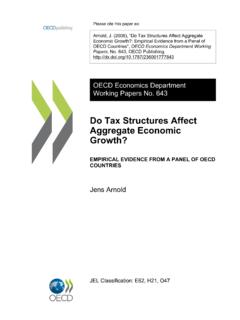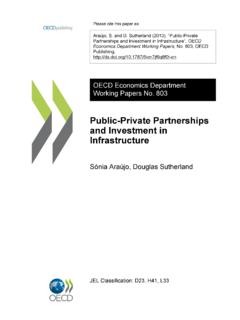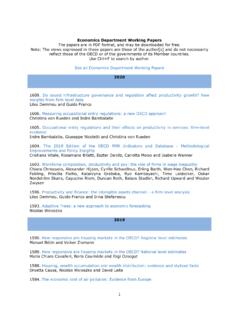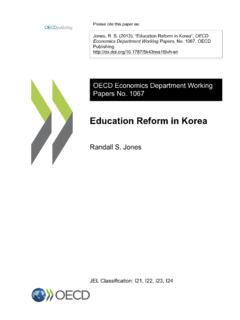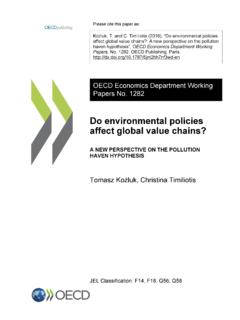Transcription of Working Papers No. 386 OECD Economics Department
1 Please cite this paper as: Roseveare, D. and M. Jorgensen (2004), Migration and Integration of Immigrants in Denmark , OECD Economics Department Working Papers , No. 386, OECD Publishing. OECD Economics Department Working Papers No. 386. Migration and Integration of Immigrants in Denmark Deborah Roseveare, Martin Jorgensen JEL Classification: H53, H6, I38, J11, J15, J21, J61. Unclassified ECO/WKP(2004)9. Organisation de Coop ration et de D veloppement Economiques Organisation for economic Co-operation and Development 08-Sep-2005. _____. _____ English - Or. English Economics Department . Unclassified ECO/WKP(2004)9. Cancels & replaces the same document of 30 April 2004. MIGRATION AND INTEGRATION OF IMMIGRANTS IN DENMARK. Economics Department Working Papers No. 386. By Deborah Roseveare and Martin Jorgensen Most Economics Department Working Papers are now available through OECD's Internet Web site at http:\\ English - Or. English JT00189092. Document complet disponible sur OLIS dans son format d'origine Complete document available on OLIS in its original format ECO/WKP(2004)9.
2 ABSTRACT/R SUM . Immigration could offer one way for Denmark to expand its labour supply, thereby lowering the dependency ratio, at least for some time, and easing the task of ensuring fiscal sustainability. However, these beneficial effects are obtained only if immigrants are in work. Yet a significant proportion of immigrants have found it quite difficult to get work in Denmark, while the country has been relatively unattractive to high-skilled foreigners. Furthermore, the structure of the economy not only makes it difficult for low-skilled foreigners to gain a foothold in the labour market, but also provides generous social benefits that have caught many of the least skilled immigrants in a benefit trap. A heightened appreciation of these problems, including a tighter focus on the economic situation of the immigrants already present, have underpinned the main changes in policies on immigration in recent years. JEL classification: H53, H6, I38, J11, J15, J21, J61.
3 Keywords: Denmark, immigration patterns, demographic projections, participation rates, integration policies, language skills, wage compression, benefit traps, fiscal sustainability. * * *. L'immigration pourrait tre, pour le Danemark, un moyen d'accro tre son offre de main-d' uvre. Cela ferait baisser le taux de d pendance, pour quelque temps du moins, et serait propice la viabilit . budg taire. Toutefois, ces effets b n fiques ne se font sentir que si les immigrants sont pourvus d'un emploi. Or, un pourcentage non n gligeable de cette population a eu de graves difficult s trouver du travail dans ce pays qui, par ailleurs, n'attire que relativement peu de travailleurs hautement qualifi s. De surcro t, non seulement la structure de l' conomie danoise permet difficilement aux trangers faiblement qualifi s de s'ins rer sur le march du travail, mais le pays est g n reux en mati re d'octroi de prestations sociales, ce qui fait que beaucoup d'immigrants les moins qualifi s se sont trouv s pris au pi ge de l'assistance.
4 Ces derni res ann es, les principaux changements apport s aux mesures concernant l'immigration ont t inspir s par une perception plus aigue de ces probl mes, en particulier par une plus grande attention la situation conomique des immigrants d j pr sents sur le territoire. Classification JEL : H53, H6, I38, J11, J15, J21, J61. Mots cl s : Danemark, tendances des flux d'immigration, perspectives demographiques, taux de participation, politiques d'int gration, comp tences linguistiques, compression des salaires, pi ge des prestations sociales, viabilit budg taire Copyright OECD 2004. All rights reserved. Applications for permission to reproduce or translate all, or part of, this material should be made to: Head of Publications Service, OECD, 2 rue Andr -Pascal, 75775 PARIS CEDEX 16, France 2. ECO/WKP(2004)9. TABLE OF CONTENTS. Demographic developments and long-term 5. Immigration 11. Entry policies .. 16. Asylum 17. Family reunification .. 18. Highly skilled immigrants.
5 19. Improving the integration of immigrants from less-developed 21. The importance of a 21. Addressing the skills 26. Language skills .. 30. 33. The benefit 35. 38. Bibliography .. 40. Annexes I. Demographic projection assumptions .. 44. II. Basic mechanisms and assumptions in the projection of public finances .. 46. III. Refugees and asylum seekers in the Aliens Act 2002 .. 52. IV. Benefit traps .. 53. Boxes 1. Welfare assistance for asylum seekers .. 17. 2. Integration through the 24. 3. Recommendations on policies for immigrants .. 39. Tables 1. Population 6. 2. Possible change in total hours worked from demographics and labour market trends .. 10. 3. Effects on fiscal sustainability of various changes to assumptions .. 10. 4. Participation rates among different immigrant groups .. 15. 5. Working -age population outside the labour force .. 16. 6. Family reunification permits granted and 19. 7. Gross income for self-employed and wage-earners .. 25. 8. Education and labour market 28.
6 9. School-to-work 29. 10. Danish language 31. 11. Concentration of immigrants by municipalities .. 34. 3. ECO/WKP(2004)9. 12. Years on social assistance, municipal activation or retraining programmes .. 36. 13. Disposable income gaps between work and unemployment .. 36. A1. Central and local government primary 46. A2. Long-term requirements for general government finances .. 49. A3. Indicators of fiscal sustainability in various 50. Figures 1. Participation rates by age, gender and origin .. 8. 2. Demographic impact on the labour force .. 9. 3. Residence permits 11. 4. Population by age and 12. 5. Inflows of foreigners to selected OECD 12. 6. Employment gaps for immigrants .. 14. 7. Labour force participation by age at arrival .. 15. 8. Recognition rates for asylum seekers .. 17. 9. Annual after-tax income for high-earners in selected OECD countries .. 20. 10. Unemployment rates by country of 22. 11. Low-skilled jobs and wage 23. 12. Educational attainment of Danes and 27.
7 13. Reading literacy 32. 14. Net replacement rates for four family types .. 37. A1. Elements shaping the pressure on public finances .. 48. 4. ECO/WKP(2004)9. MIGRATION AND INTEGRATION OF IMMIGRANTS IN DENMARK. Deborah Roseveare and Martin Jorgensen1. This Working paper first sets out the link between migration and long-term fiscal sustainability. It then examines trends in immigration since the early 1960s and the key demographic characteristics of the foreign population. The next section reviews the entry policies that currently apply for those immigrants from outside the European economic Area. The recent changes affecting each main type of entry . asylum seekers, family reunification and highly skilled immigrants are set in an international context and linked back to the authorities' wish to better integrate those immigrants that are already in Denmark. The challenges of integration are discussed in the following section. The government's ultimate goal is that foreigners participate in economic activity on an equal footing with native Danes.
8 Such an ambitious goal will obviously not be reached quickly or easily, and the authorities consider the critical intermediate objective to be getting more immigrants into jobs as a prerequisite to their future economic success. The measures already put in place go in the right direction, and the concluding section makes some suggestions as to how policies might be improved further. Demographic developments and long-term fiscal sustainability Almost all OECD countries face significant changes in the size and composition of the population in the years ahead. The common pattern of ageing populations basically stems from the same combination of a baby boom in the early post-war period succeeded by declining fertility rates and increasing life expectancy. The impact on growth potential and especially public finances from these developments will be substantial in most countries, given the current institutional settings. Output growth will, other things equal, slow as labour forces shrink.
9 Public expenditure will increase with the number of elderly, while the reduction in labour forces tends to erode tax bases, thus raising concerns about intra- and inter-generational income distribution. Developments in individual countries will depend not only on the specific demographic and labour force characteristics but also to a varying extent on the size and composition of net immigration, though the levels of immigration that would be required to make the demographic picture outlined above distinctly more favourable are probably not imaginable for most countries (Roseveare et al., 1996). However, it will make a significant difference to the labour supply whether immigrants are highly qualified 1. The authors are economists at the OECD. This paper draws on material originally produced for the OECD. economic Survey of Denmark published in June 2003 under the authority of the economic and Development Review Committee. The authors are indebted to colleagues in the Economics Department of the OECD for comments and drafting suggestions, in particular Peter Jarrett, Mike Feiner, J rgen Elmeskov, Val Koromzay, Andrew Dean, Paul O'Brien and Ann Vourc'h.
10 Special thanks go to Sandra Nilsson for background research, and to Raoul Doquin de Saint Preux and Mee-Lan Frank for technical assistance. 5. ECO/WKP(2004)9. and active in the workforce or instead arrive with little potential for becoming self-supporting without a major amount of public assistance. 1. Table 1. Population projections 2000 2020 2040 2100. 1 000 persons By age group 0-14 years 981 872 942 1 074. 15-64 years 3 558 3 589 3 384 3 611. 65 years and above 790 1 052 1 223 1 182. Total 5 330 5 513 5 548 5 867. Index 2000 = 100. 0-14 years 15-64 years 65 years and above Total Proportion of total population, per cent 0-14 years 15-64 years 65 years and above 1 000 persons By origin Immigrants from LDCs 147 323 481 618. Immigrants from MDCs 150 205 240 257. Descendants from LDCs 60 181 327 570. Descendants from MDCs 21 40 62 116. Remaining population 4 952 4 764 4 439 4 305. Total 5 330 5 513 5 548 5 867. Index 2000 = 100. Immigrants from LDCs Immigrants from MDCs Descendants from LDCs Descendants from MDCs Remaining population Total Proportion of total population, per cent Immigrants from LDCs Immigrants from MDCs Descendants from LDCs Descendants from MDCs Remaining population 1.



